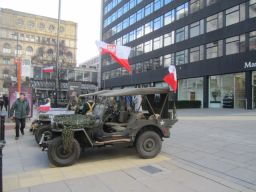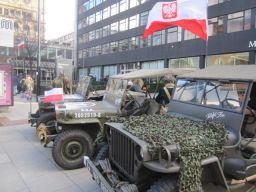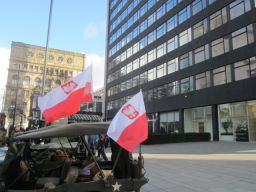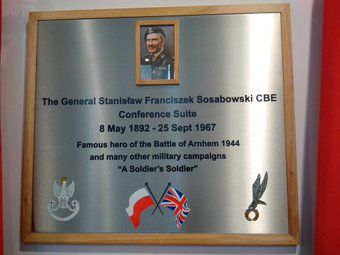


Events (2016) pt 1
Polish Embassy
Ian McCormack has provided this comprehensive report from a visit our group made to the Polish Embassy in Manchester following an invitation to attend a Commemorative event there. Over to you Ian.
In January 1941, a momentous event took place with the formation of the Polish 1st Independent Parachute Brigade at RAF Ringway – the present day Manchester Airport. On 30 January 2016, the 75th anniversary of the Brigade’s formation, a plaque was unveiled at the Polish Consulate in Manchester to honour the deeds of the Brigade and their leader, General Stanislaw Sosabowski.
Following the fall of France in June 1940, the remnants of the Polish Army which had been fighting in France were evacuated to Britain. Of 84,500 troops, just 24,000 were able to make it to the UK. Based in Scotland, this core of battle hardened soldiers formed the nucleus of a resurgent Polish Army who, bolstered with further escapees from Poland and overseas territories, returned to liberate Western Europe in August 1944 as part of 21st Army Group. From the Normandy beaches they fought right through to VE Day, a notable action (amongst a string of battle honours) being the closing of the Falaise Pocket in Normandy, trapping the retreating German Army.
Shortly after the Poles had arrived in Britain from the disaster of the French collapse, thoughts were already turning to striking back against the Nazi invaders of the Polish homeland. In pursuit of this aim, January 1941 saw the formation of the Polish First Independent Parachute Brigade under General Stanislaw Sosabowski at No.1 Parachute Training School at RAF Ringway. The original plan for this Brigade, formed from Polish volunteers, was to assist a planned uprising by the Polish underground resistance – the Home Army.
Whilst the original plan never came to pass, the Brigade was ultimately deployed in Operation Market Garden, fighting hard at Arnhem with many losses and covering the eventual withdrawal of the survivors from this ill-starred mission across the Lower Rhine River.
To support the 75th Anniversary commemorations, the Consul General of the Republic of Poland in Manchester had invited re-enactors and military vehicle owners to the event which was held in Manchester city centre. Keith and Celanie Ball, Dave Salisbury and Ian McCormack accepted the invitation and made their way along a bitterly cold A6 through such picturesque villages as Walkden and Little Hulton to the heart of the city. Undaunted by No Entry signs, buses, pedestrians and other such impedimenta, the Jeeps were soon parked up in front of the Consulate on Portland Street.
Keith’s Jeep was most appropriate for this event having served with the Polish Army in the desperate fighting at Monte Cassino in 1944. Somehow surviving intact it ended up in the UK where it was eventually restored by Keith, making its first major outing to Normandy in 2014. Sporting both the pine tree symbol of the 3rd Carpathian Rifle Division and Wojtek the Bear of the 22nd Artillery Supply Company, it makes an interesting contrast to more commonly seen US and British Jeep markings.
At the Consulate door, the sight of airport-style scanners and ‘well-built’ short-haired gentlemen caused a slight pause (especially for those who were ‘packing heat’) but the Polish hospitality soon overcame that and hot coffees rapidly thawed everyone out.
Shortly after, the room began to fill as Pete Cartner from Manchester MVT landed with a GMC load of Polish re-enactors in full Para gear having come from a demonstration and talk at the Polish Saturday school in Manchester.
Various guests and dignitaries arrived including the most important guests of all – a number of Polish veterans who had fought in WW2 including several who were at Arnhem with one gentlemen having served right through to Korea!
Of course, Polish hospitality doesn’t stop at a few cups of coffee and a delicious soup was served to everyone followed by a sumptuous buffet. For the non-drivers a constant supply of wine was available with the inevitable vodka (50% proof of course) for those preferring the harder stuff (most people there by the looks of it).
With the Jeeps attracting plenty of attention, albeit well guarded by the Polish Paras, an hour or two was spent talking to passers by and explaining why there were Jeeps and armed soldiers in the middle of Manchester on a Saturday afternoon. Never were more selfies taken by so many of so few (with apologies to Mr W. S. Churchill).
The unveiling of the commemorative plaque was performed by the High Sheriff of Manchester with Scottish piper and regimental flags in attendance followed by even more food and drink. By now the audience was so big that the proceedings had to be broadcast through to the reception area for those unable to get in to the unveiling venue.
With the day wearing on and conscious of the time, leave was taken of the assembled throng and the three Jeeps battled their way through the Manchester traffic, the hail and the snow to home.
It was a great honour and a privilege to have been able to take part in a commemoration of some very brave men who, it should not be forgotten, were ‘first to fight’ but did not regain the freedom of their homeland until 1990 with the fall of the Soviet Union - too late for many who were never able to return home.
Polska, dziękujemy i salutują was! (Poland, we thank and salute you!).

Tesco Help For Heroes
Across the country Tesco stores have been raising money for Help For Heroes. The Blackpool store was no different. They asked for help from our Area to provide a couple of vehicles to park around the entrance to the Store, and to form a backdrop to the Army Cadets who were doing the actual collection. On the Saturday, Ian Wray and Esther Crane turned up in their Jeep accompanied by Norman with his Lightweightt LandRover. Ian managd to manoeuver his Jeep into the actual entrance while Norman took up post outside. On the Sunday I turned up with my LandRover 110 and considered doing what Ian had done. A quick examination of the surrounding area put me off with bollards and other obstacles strategically placed to stop a vehicle like mine gaining access. So I parked outside the entrance to be joined later by Norman with his Lightweight.
The day was spent chatting briefly to the leaders of the Army Cadets and to Norman. Our photos were taken by the Store manager that later appeared in the Blackpool Gazette. I am told the amount raised over the weekend was in the order of £1500 - £1900.
Ye Horns Crank up
Ian McCormack has put pen to paper (well finger to computer keyboard really) to describe the first main event on our diary. Over to you Ian.
"The first weekend of April is the cue for South Cumbria & North Lancs Area’s crank up, held at our regular haunt of Ye Horn’s Inn near Goosnargh, a small village deep in the Lancashire countryside, a few miles from Preston. Whilst a number of smaller events take place during winter, this is the first occasion in the year when a goodly number of the group can get together and give their vehicles an airing.
Early April holds the promise of blue skies, birds in the trees, lambs in the fields (you get the picture) but, alas, Friday afternoon into Saturday was decidedly dreich (guess we’re close enough to Scotland to use that word). As has become the norm at the Horn’s Inn events, there are two concurrent road runs organised; a serious stretch out taking advantage of the proximity to the Forest of Bowland and the Yorkshire Dales and, for those wishing to return sooner to warm fires and fine ales, a shorter (but still significant) run through more local environs.
A consideration of the weather concluded that the runs should go ahead (“only a bit of rain” as Noah’s neighbours might have said) and those prepared for the longer run formed up and moved out as soon as everyone had arrived. Five vehicles took on the challenge - Ian McC (with Paul and Helen for company and map reading), Jonathan & Boyan and Jon in Jeeps, Tony and Dave in a GAZ-67 and Paul H in a Land Rover 110.
Despite the nearby fells (which were the direction of travel), being shrouded in low cloud, there was nothing for it but to press on…. After only a short distance, alterations to the route were already being made, as a landslip forced a diversion around Whitewell sending the party further south and east towards Clitheroe.
Swinging back northwards through West Bradford (which is very different to its larger namesake over the Pennines) the road led over Waddington Fell. On a good day you can see for miles from here – this wasn’t a good day so visibility was just the road in front. Well, for those with electric windscreen wipers at least!
The little detour eventually joined up with the originally planned route at Slaidburn and the road east towards Yorkshire via Tosside. This area of countryside is a kind of ’debatable land’ between Lancashire and Yorkshire where you are never quite sure which is which. Slaidburn itself is currently part of the Ribble Valley district of Lancashire but is historically in the West Riding of Yorkshire. Whatever, it’s a beautiful part of the world and well worth a visit.
Turning north again, the route entered Gisburn Forest on the eastern side of Stocks Reservoir. A welcome stop was taken at the cycling centre in the forest for hot drinks and a ‘comfort’ break – much needed due to all that cold air and bouncing round in military vehicles on the potholed roads of the district!
Once back on the road and clear of the trees, a long climb along the single track road over the mist shrouded Clapham Common (not that one – this is the quiet one with just sheep and curlews for company) dropped down to the village of Austwick – a kind of gateway to the Yorkshire Dales.
Now into the National Park; the numbers of walkers and cyclists was noticeably higher, all wrapped up against the spring weather and determined to get out and about. The area is very popular walking country being part of the route round the Yorkshire three peaks of Ingleborough, Pen-Y-Ghent and Whernside. Not exactly mountains by Scottish or Cumbrian standards, it is still a stiff challenge to climb all of them in one 26 mile circuit.
Hawes was the destination for lunch with fish and chips beckoning but not before admiring the spectacular Ribblehead viaduct, a 24 span railway bridge across Batty Moss and part of the Settle to Carlisle railway. Built by one thousand navvies between 1870 and 1875 the working conditions endured in their shanty towns up on the wind and rain swept moors can only be imagined. Around one hundred navvies were killed during its construction and are buried at a local churchyard.
Finally reaching the busy Dales town of Hawes everyone headed for the chippy – a bit like a pot of gold at the end of the rainbow…. only better. Unfortunately all seats in the attached café were taken so, after a long cold drive, dinner was eaten standing on the footpath in the rain much to the chagrin of one of the gang who, feeling a little under the weather, had been promised a nice warm sit down meal. Sorry!
Conscious of the time, a decision was made to take the quick(!) way back to Horn’s Inn, a mere 50 miles or so away across hill and dale. Retracing tyre tracks past Ribblehead led through Ingleton to High Bentham, still in Yorkshire and a hub of the farming community with an active auction mart and several pubs. Leaving High Bentham behind, the road climbs steeply towards the Cross of Greet. Now consisting of just a boulder with a hole in the top (no cross anymore) it stands on the highest point of the road and marks the traditional boundary between Yorkshire and Lancashire.
A brief stop was made for a stretch of legs and to take in the tranquillity of the countryside; the quiet up here is almost overwhelming broken only by the haunting song of curlews and the ‘go-back, go-back’ calls of red grouse which breed on these high fells.
Moving on, the road wends its way across bleak moorland through steep sided cloughs and across the hill tops before finally dropping down into softer, wooded countryside and the village of Slaidburn. This actually completed a full circuit of Stocks Reservoir, albeit a very long circuit! Opened in 1932, the reservoir was constructed by Fylde Water Board to supply fresh water to the growing population of Blackpool and the Fylde. Still a working reservoir it is also an important fishing site and wildlife habitat.
Revived by a brew at Slaidburn’s Riverbank Tea Rooms and the late appearance of a watery sun, the band of travellers struck out on the last leg of the quest through the Hodder valley and Dunsop Bridge. The village is famous as the geographical centre of Great Britain and was also the location of BT’s 100,000th payphone (unveiled by no less than Sir Ranulph Fiennes in 1992). As nice as the run out had been, this was the best part of the journey with the views along this valley being amongst the finest in England (and, therefore, the world). Next time Her Majesty pops in for tea, just ask her – it is known that this is one of her favourite places in Britain.
And so back to the pub for fine food, a roaring fire and good company. All agreed that it was a great start to the season and how lucky we are to have such glorious countryside on our doorstep – over 110 miles and all on B or unclassified roads.
Thanks for another good weekend must go to Jim Ashcroft, Ken Marle and Dave Fellows for making it happen and also to Mark, landlord at the Horn’s Inn for his continued hospitality."
The weekend itself was fairly wet but we weren't flooded and had somewhere warm and dry only a few steps away. On Sunday, wet tents were put away as the sun came out to greet us. Just typical! One of the photos below shows one of our newer members Patrick and Angela putting a tent away after a weekend under canvas. From what I heard, I'm not sure they will be doing it again, but we'll see.We will be back though for the Beer Festival.
Heaton's Bridge Crank up
What a collection of vehicles!! This sums up the comments most people that I saw over the weekend nade. From Jeeps to some very heavy trucks and armoured vehicles too. Heaton's Bridge had it all. Add in the road run on Saturday and an off road experience on Sunday, the weekend was a roaring success. Late arrivals, as I was, though to be fair it was early Saturday morning that I arrived, meant camping was at the far end of the field with ony room for a couple more tents.
The road run comprised about eight vehicles with a width restriction so that we could pass over a Bailey Bridge that is still in very day use. We ended up at the Delph Diving Centre for a brew and a rest, where we were infomrd a Saracen Armoured car was at the bottom of the pit for the divers to go and examine. As there was a Saracen parked up back at the pub, I'm sure some were wondering how we could get some spare parts from down below.
The off road run on Sunday comprised 4 Pauls, and Frank Brown, but we'll call him Paul to avoid confusion. There were two Pauls with Land Rover 110s, Higgins and Harrison, Paul Sennant with his Leyland, Paul Connolly with his Jeep and Paul Brown with his Morris Quad, limber and 25 pounder. They all managed to get over the off road course, eventually. Remember Paul that the Leyland has a diff lock especially for those muddy patches. Paul's Land Rover 110 tyres soon filled with clay on one stretch and had to be retrieved. I apologise for wimping out as I had agreed to go after Paul down that muddy gully but after he got stuck, cowardice overtook valour.
Slight rain as tents were being taken down caused some upset but for the most part the weekend weather was superb if a little cold at night. Well done to all involved in organising the event, it is one well worth going to. Special thanks to Angie for the Spam fritters and the St Geroge's day quiz.
Brougham Hall, Penrith
On the outskirts of Penrith lie two ruins, Brougham Castle on the banks of the river, and Brougham Hall a little further inland. We were invited to help arrange a 40s weekend at the Hall, built in the fourteenth century, so Boyan and Susie agreed to help set up the event. The weekend came amid sweltering sun and almost freezing cold nights. The location was praised by most of the people I spoke to with high walls, some ruins, and some rebuilt sections. The rebuild started in 1985 following the purchase of the Hall to prevent its demolition to make way for a new building project. The Hall hosts a number of small businesses including the Eden Brewery that fortunately for us were selling their bottled beers from a stall. Bin ends at a pound per pint was what I would call a bargain. So much so that Norman bought 24 bottles to make sure the stock stayed with us. The 40s tents and vehicles were set up in the court yard, in pride of place, whereas the post war vehicles, Land Rovers really, were parked on what appeared to be a lane alongside the Hall. Only after the tents were pitched and the vehicles parked up did we realise the "Lane" was actually on top of a wall that was buttressed to avoid it falling over or collapsing. It worked as the wall had been standing like that for a few hundred years, not with a few Land Rovers and Jeeps on top of it though.
A road run on Friday evening around the countryside near Penrith enabled a few of us to admire the scenery rather than concentrate on driving. Thanks to the drivers for allowing us on your Jeeps. A few short runs out over the weekend around Penrith to advertise the event got some of the vehicles out and about causing quite a bit of interest and a thumbs up from the local constabulary.
A barbecue was set up on Saturday night by Kevin, John and Boyan so it was a case of grill what you brought and enjoy the atmosphere. Later on a fire in the sunken garden kept us warm listening to stories of a ghost that was supposed to go from the garden to the Hall's chapel, straight through Norman's tent.
During the weekend we saw a good number of visitors coming to the Hall to look around the ruins and the displays put on by the MVT and Northern WW2 Association. The visitors thought the event was good and so did we so we can't wait until next year. Thanks to Stuart Reid and Jim Ashcroft for the additional photography.